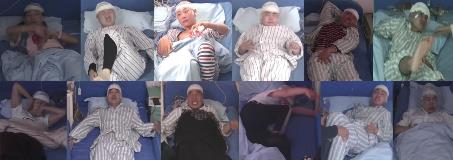Anatomo-Electroclinical Features of Perisylvian Epilepsy: An Evaluation in 26 Patients
Abstract number :
3.193
Submission category :
4. Clinical Epilepsy / 4B. Clinical Diagnosis
Year :
2018
Submission ID :
506370
Source :
www.aesnet.org
Presentation date :
12/3/2018 1:55:12 PM
Published date :
Nov 5, 2018, 18:00 PM
Authors :
Xiu Wang, Beijing Tiantan Hospital, Capital Medical University; Wen-han Hu, Beijing Neurosurgical Institute, Capital Medical University; Chao Zhang, Beijing Tiantan Hospital, Capital Medical University; Lin Ai, Beijing Tiantan Hospital, Capital Medical Un
Rationale: To report the clinical experience with presurgical evaluation in patients with perisylvian epilepsy and summarize the anatomo-electroclinical characteristics in these patient group. Methods: 26 patients with focal epilepsy involving insular and/or opercular epilepsy and receiving resection surgery were retrospectively analyzed. The presurgerical workup included video-EEG, MRI, interictal positron emission tomography with 18F-?urodexyglucose (18FDG-PET) and/or stereo-electroencephalography (SEEG). Then, the interictal PET data of patients was compared with those of 18 healthy controls using statistical parametric mapping (SPM) to identify interictal hypometabolic network. Epileptogenicity index (EI) was computed for two habitual seizures of each patient to identify the spreading areas at the beginning of seizure onset. Structures disclosing EI values > 0.4 were considered to be highly epileptogenic and we further tried to classify the perisylvian epilepsy according to the calculated EI value of insular and opercular cortex. Results: Focal tonic or clonic seizures restricted in unilateral perioral areas were present in 12 patients (46%). Axial tonic contraction, especially neck tonic flexion (12, 46%, Fig.1) with or without tonic in upper limb, was another prevalent early symptoms. Bilateral asymmetric tonic posturing and/or hyperkinetic automatisms were the most prevalent complex motor signs (8, 31%). Multifocal distribution of slow wave or spike wave was the most prevalent in interictal EEG and ictal patterns were various, including ictal voltage depression and low voltage fast activity, rhythmic electrical activity ranging fromdto aband, burst of rhythmic spike, no clear EEG changes and late movement artifact. PET SPM analysis showed significant hypometabolism in insular lobe, ipsilateral central operculum, ipsilateral supplementary motor area (SMA), ipsilateral middle cingulate cortex (MCC), bilateral caudate nuclei and putamen (Fig.2). Twenty patients underwent a total of 171 SEEG electrodes implantations. Fourteen patients had simultaneous SEEG electrodes implantation in insular cortex, operculum and SMA/CMA. The most epileptogenic structure was the opercular cortex (mean EI value ± SD: 0.77±0.27), followed by insular cortex (mean EI value ± SD: 0.62 ± 0.32) and SMA/CMA (mean EI value ± SD: 0.44 ± 0.31). We found that 10 patients belonged to insulo-opercular epilepsy (50%, EI values of both insular and opercular cortex were higher than 0.4). Then, 8 patients belonged to opercular epilepsy (40%). However, only two patients belonged to “pure” insular cortex (10%).Figure legends: Fig. 1 Neck tonic flexion with or without tonic in upper limb in patients with perisylvian epilepsy. Figure 2. PET SPM analysis showed significant hypometabolism in insular lobe, ipsilateral central operculum, ipsilateral supplementary motor area (SMA), ipsilateral middle cingulate cortex (MCC), bilateral caudate nuclei and putamen. Conclusions: Focal tonic or clonic seizures restricted in unilateral perioral areas and neck tonic flexion were two of the most prevalent simple motor seizures in perisylvian epilepsy. Insular and opercular cortex were closely interconnected structures and SMA/CMA were also included in the early spreading areas, which were associated with the complex motor behavior in perisylvian epilepsy. Funding: This work is partly sponsored by the Capital (China) Health Research and Development Special Fund (2016-1-1071), Beijing Municipal Science & Technology Commission (Z161100000216130 ), and Beijing Municipal Administration of Hospitals’ Ascent Plan (DFL20150503).
